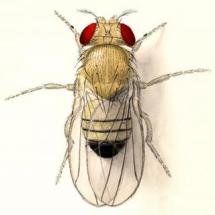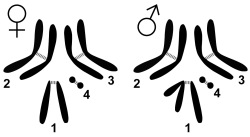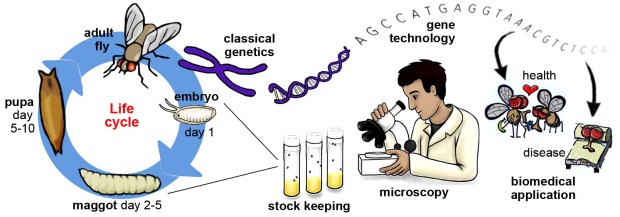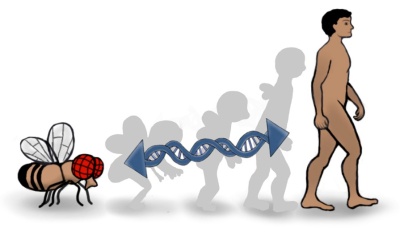Drosophila melanogaster ter, more commonly known as the fruit fly or vinegar fly, has been used as a model for biological research for over 100 years (explained in our first movie below). To date, Drosophila is the conceptually best understood animal organism in the biomedical sciences, ideal also to be used as a teaching tool in schools to convey fundamental concepts of biology (explained in this blog). Six Nobel Prizes in “Physiology or Medicine” were given to 10 researchers who made their groundbreaking discoveries in Drosophila (see box below), and many aspects of modern medicine are based on foundations laid through fly research (explained in our second movie below). But how can such a small, invertebrate organism teach us anything about human biology?
ter, more commonly known as the fruit fly or vinegar fly, has been used as a model for biological research for over 100 years (explained in our first movie below). To date, Drosophila is the conceptually best understood animal organism in the biomedical sciences, ideal also to be used as a teaching tool in schools to convey fundamental concepts of biology (explained in this blog). Six Nobel Prizes in “Physiology or Medicine” were given to 10 researchers who made their groundbreaking discoveries in Drosophila (see box below), and many aspects of modern medicine are based on foundations laid through fly research (explained in our second movie below). But how can such a small, invertebrate organism teach us anything about human biology?

6 Nobel Prizes for “Physiology or Medicine” to 10 scientists for ground-breaking work in Drosophila:
- 1933: Thomas Hunt Morgan – The role played by chromosomes in heredity
- 1946: Hermann Joseph Muller – The production of mutations by means of X-ray irradiation
- 1995: Edward B. Lewis, Christiane Nüsslein-Volhard, Eric F. Wieschaus – The genetic control of early embryonic development
- 2004 : Richard Axel – Odour receptors and the organisation of the olfactory system (mainly rodent work)
- 2011: Jules A. Hoffmann – The activation of innate immunity
- 2017: Jeffrey C. Hall, Michael Rosbash, Michael W. Young – molecular mechanisms controlling the circadian rhythm
What flies have taught us
As is explained in the first film below, Drosophila research at the beginning of last century has seeded the field of Genetics and laid essential foundations for modern biology, and work in flies has given us essential understanding across a wide spectrum of fundamental biology since then. Flies have taught us how genes are organised on chromosomes and the rules of inheritance, numerous mechanisms of how gene activity is regulated, the nature of mutations and danger of radiation. They have given us the first genes for information processing in nerve cells and learning, an understanding of the biological 24 hr clock that organises our daily schedules and causes jet lag, principles of embryonic development including the formation and fundamental organisations of the nervous system, key mechanisms of the immune system, rules of gene pool dynamics in large populations (population genetics), as well as the first artificially generated animal species (Drosophila synthetica) demonstrating how evolution works. Moreover, work in flies is advancing our understanding of the importance of nutrition for biological performance and longevity, and the fundamental biology of stem cells and cancer (cell division, cell communication). Drosophila is even helping us to understand how certain genetic defects can lead to a range of diseases including brain disorders (e.g. Alzheimer’s and Parkinson’s disease), and many aspects of modern medicine are based on foundations laid through fly research. For more information on how fly can be used and how it contributes to the process of scientific discovery, read examples provided by these lay articles, the “Organs” tab and this NINDS blog. To express it in a more engageing way:
Publications explaining the Drosophila phenomenon
- Brookes, M. (2001/2002). “Fly: The Unsung Hero of Twentieth-Century Science.” Ecco/Phoenix, — [LINK]
- Held Jr., L. I. H. (2017). “Deep homology? Uncanny similarities of humans and flies uncovered by evo-devo.” Cambridge University Press, Cambridge — [LINK]
- Kohler, R. E. (1994). “Lords of the fly. Drosophila genetics and the experimental life.” The University of Chicago Press, Chicago, London — [LINK]
- Lawrence, P. (1992). “The making of a fly: the genetics of animal design.” Blackwell Science, Oxford — [LINK]
- Prokop, A. (2016). Fruit flies in biological research. Biological Sciences Review 28, 10-14 — [LINK]
- Prokop, A. (2018). Why funding fruit fly research is important for the biomedical sciences. Open Access Government 20, 198-201 — [LINK and as GSA blog]
- Mohr, S. E. (2018). “First in fly – Drosophila research and biological discovery.” Harvard Univ. Press, Cambridge, MA and London, UK — [LINK]
- Weiner, J. (1999). “Time, Love, Memory : A Great Biologist and His Quest for the Origins of Behavior.” Vintage Books, Random House Inc., New York — [LINK]
Further info resources can be found here.
The 1st key: cost-effective & efficient
The 1st key lies in the pragmatic advantages of Drosophila which allow rapid progress and fuel therefore widespread use of flies in biological research:
- Research in flies is highly cost-effective, affordable even for scientists on a budget. They are easy and cheap to breed in great numbers, and the equivalent of the population of London can be kept on a handful of laboratory trays. These tiny organisms are therefore ideal for large-scale or high-throughput experiments, as an important prerequisite to gain deeper conceptual understanding of biological processes.
- Fruit flies have a short life span (two months) and generation cycle (10 days): they become grandparents in as little as 3 weeks. Therefore, family trees over many generations are quickly drawn, and research progresses much faster than in more complex animals. Where experiments in flies usually take weeks or a few months, they last many months or years in a mouse.
- A further factor speeding up research is the fact that there are very few legal restrictions for research on flies, and experiments can be started straight off the drawing board (rather than having to wait for formal approval).
-

The 4 chromosome pairs in Drosophila: the 4th is very small, the 1st is XX in females and XY in males
Drosophila is ideal for genetic analyses, because it has only 4 chromosomes. This makes it easier to handle gene mutations, alone or even in combinations, i.e. to study their fundamental functions within genetic networks and decipher complex biological processes. Understanding derived from such research, presents a valuable template for work in higher animals (see 3rd key below).
- Drosophila can be easily handled and maintained in great numbers. Compared to keeping larger animals, the culturing of flies comes at very low cost and requires little space, as is explained in the figure and legend below.

Flies are kept in vials with food at the bottom (B), which can be stored in large numbers in laboratory incubators (A); great numbers of flies can be easily monitored under the microscope (C,D) on a purpose-made pad (E) which dispenses CO2 gas to anaesthetise them for a few minutes.
- Thanks to the efficient procedures for breeding flies, it is easy to produce genetically identical progeny in large numbers. This makes experimentation easier, because there is little variation between different individuals and results obtained are reproducible. Individual genetic backgrounds (which pose a problem in human medicine and require personalised medicine), can be excluded as a factor of uncertainty during experimentation.
- Thanks to the efficient procedures for breeding flies, it is also easy to perform so called genetic screens. Such screens involve that large numbers of flies are treated with substances that cause mutations; the progeny of these treated flies is then analysed (sreened), as to whether they show aberrations that concern a biological process of interest. Fly strains with such aberrations are then isolated and bred into cultures for further analysis. Such screens and their follow-up analyses, have led to the discovery of many important genes and helped to reveal the genetic basis of many biological processes (second movie below).

Flies develop fast and are highly amenable to genetics and other experimentation – ideal to study genes, biological processes and even mechanisms of disease.
- Drosophila is so small that whole embryos or whole fly organs or brains can be analysed in one go at high resolution under the microscope or even reconstructed in 3D (see first movie below showing embryonic development live from two angles, or second movie with 7 parallel cellular labels in one animal). Microscopic data are therefore easy to obtain and interpret – for example when studying the impact of a gene mutation on embryonic development. Surprisingly, the small size of fly embryos (0.5 mm long!) does not deter scientist from other kinds of experiments, and feasible strategies were developed to dissect these tiny specimens for taking out organs, manipulating or labelling specific cells, or performing sophisticated physiological measurements.
The 2nd key: knowledge & infrastructure
The 2nd key lies in the long history of Drosophila research. Flies were introduced as genetic model organisms by T.H. Morgan over 100 years ago (LINK1, LINK2), and have stayed at the forefront of biological research since. Once knowledge and know-how starts building up, this tends to accelerate subsequent developments. This has led to a continuous and unprecedented build-up of…
- … knowledge about fly biology which is uniquely profound,
- … cutting-edge, highly refined, powerful (and constantly improved) research strategies and technologies for Drosophila.
- … an ample portfolio of fly-specific resources and infrastructure.
For example, virtually every gene of Drosophila is amenable to experimental manipulation with genetic tools that can usually be readily ordered from stock centres. If combined with the highly sophisticated and efficient research strategies available, the ample pre-existing knowledge of relevant biological contexts facilitating interpretation of results, and the speed and cost-effectiveness of fly research (see key 1) enormous progress can often be achieved in impressively short time periods.
The 3rd key: similarity
The 3rd key lies in our shared evolutionary roots and history. Thus, many of our organs still share fundamental principles of their organisation and function (see details here). Consequently, the genes and fundamental biological processes underpinning health and disease in humans are often very similar to those that can be studied in Drosophila, and it has been estimated that “…about 75% of known human disease genes have a recognisable match in the genome of fruit flies” (Reiter et al., 2001, Genome Res 11, 1114ff). Therefore, flies are often used as “test tubes” to pioneer research on a gene or biological process of interest, followed by work aiming to determine whether the new understanding obtained in Drosophila is applicable in mice or even humans. For an example, see this school article.

For almost every organ in humans there is a match in flies, and common genes regulate their development, organisation and function. Click image for more information.
This said, flies are of course NOT mini humans. For example, work on Alzheimer’s disease in flies cannot be used to study “personality loss”, a very human aspect of this disorder. But what Drosophila DOES PROVIDE are very powerful means to unravel the fundamental biological mechanisms of nerve cell decay. Since understanding this decay will be crucial for designing possible Alzheimer’s cures, it poses exciting opportunities for fly research to make crucial contributions (see further explanations & examples here). The list of cases where work in flies has inspired or significantly accelerated advances in mammalian or human research is impressive.
In conclusion…
See Drosophila educational movies
See Arabic, Spanish and Indonesian versions on our YouTube channel
For further Drosophila-related movies click here. If you want to have some fun, play the Drosophila video game:




Pingback: Outreach resources | flyfacility
Pingback: Why the Fly? | flyfacility
Pingback: Maintaining a strong Drosophila community — starting with students | Gedankenexperimente
Pingback: Guest Post: Maintaining a strong Drosophila community — starting with students - Genes to Genomes
Pingback: Genes to Genomes: a blog from the Genetics Society of America
Pingback: Bringing life into biology lessons: using the fruit fly Drosophila as a powerful modern teaching tool | Pedagoo.org
Pingback: Bringing life into biology lessons: using the fruit fly Drosophila as a powerful modern teaching tool | Gedankenexperimente
Pingback: How flies are making their way into classrooms | Faculty of Life Sciences, UoM
Pingback: Six Nobel prizes- what's the preoccupation with the fruit fly? - Bed Bugs Heat Treatment
Pingback: Six Nobel prizes- what's the obsession with the fruit fly? - Bed Bugs Heat Treatment
Pingback: Six Nobel prizes- what's the fascination with the fruit fly? - Bed Bugs Heat Treatment
Pingback: Six Nobel prizes- what's the infatuation with the pomace fly? - Bed Bugs Heat Treatment
Pingback: Six Nobel prizes- what’s the infatuation with the pomace fly? | Florida Bed Bugs Experts
Pingback: A fly on the wall account of scicomm in action | droso4schools
Pingback: Six Nobel prizes – what’s the fascination with the fruit fly? - Bed Bugs Heat Treatment
Pingback: A droso4school CPD event for teachers | droso4schools
Pingback: Six Nobel prizes- what's the fascination with the pomace fly? - Bed Bugs Heat Treatment
Pingback: 23rd April 2018 – Of Flies and Men: How tiny insects changed the world of Biology – Professor Andreas Prokop and Mr Sanjai Patel – Didsbury SciBar
Pingback: Matthew Cobb: What makes great biology? | Gedankenexperimente
Pingback: How to communicate basic research in schools – a case study using Drosophila | Gedankenexperimente
Pingback: An objective-driven long-term initiative to communicate fundamental science to various target audiences – a case study in fruit flies | PLOS SciComm - PLoS Blogs - Airiters
Pingback: A novel engaging approach to teaching life cycle and evolution in KS2 classrooms | Gedankenexperimente
Pingback: Genes to Genomes: a blog from the Genetics Society of America
Pingback: Home |
Pingback: Why funding fruit fly research is important for the biomedical sciences | Gedankenexperimente
Pingback: Why funding fruit fly research is important for the biomedical sciences |
Pingback: Training Workshop on Drosophila in Biomedical Research |
Pingback: How your science communication can turn multi-lingual! - PLOS SciComm
Pingback: An objective-driven long-term initiative to communicate fundamental science to various target audiences - a case study in fruit flies - PLOS SciComm
Pingback: How to communicate basic research in schools - a case study using Drosophila - PLOS SciComm
Pingback: Nobel Prizes for studying Drosophila – I Fly Bio
Pingback: Fruit flies shed light on how immune responses are regulated – PubNavigator